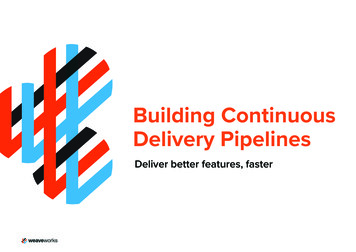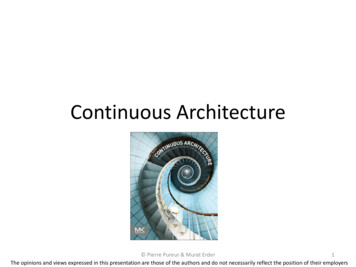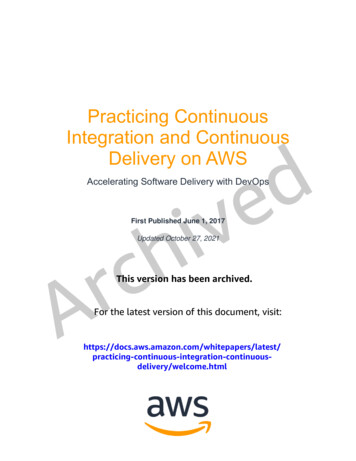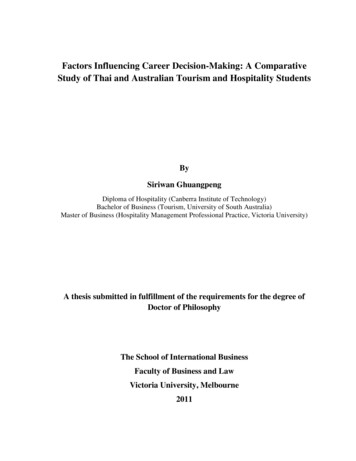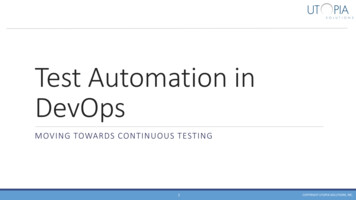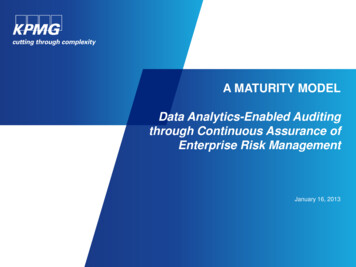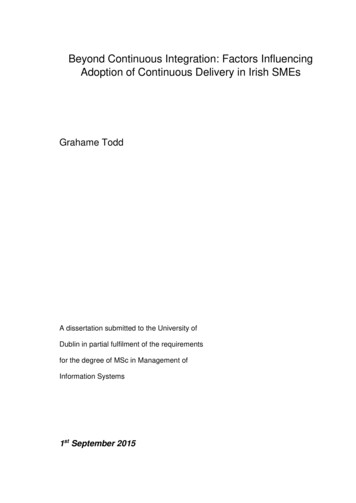
Transcription
Beyond Continuous Integration: Factors InfluencingAdoption of Continuous Delivery in Irish SMEsGrahame ToddA dissertation submitted to the University ofDublin in partial fulfilment of the requirementsfor the degree of MSc in Management ofInformation Systems1st September 2015
DeclarationI declare that this dissertation is entirely my own work and that it has not been submitted asan exercise for a degree at this or any other university. This research has been carried outin compliance with the research ethics protocol of the School of Computer Science andStatistics.Signed:i
Permission to Lend or CopyI agree that the School of Computer Science and Statistics may lend or copy thisdissertation upon request.Signed:ii
AcknowledgementsI would like to thank my supervisor Paula Roberts for all her help, guidance and words ofencouragement during the research and writing process.To those who participated in this research, thank you for giving up your time to share yourknowledge and experiences.Thanks to all my family and to my parents for their support.Most of all, I would like to thank my wife Alison for all her incredible support, help andpatience during the research process and for keeping me smiling throughout.iii
AbstractModern software companies are under pressure to develop high-quality software faster thanever before, while keeping risks to a minimum. Adding to this pressure, experimentationand rapid feedback are playing an increasingly important role in software productdevelopment, allowing the most agile companies to gain a competitive advantage.Continuous Delivery is a promising addition to modern software development practices,offering practitioners the ability to deliver quality software to the customer in shorteriterations, while learning and experimenting with every release.This research investigates the extent of Continuous Delivery use in small to medium-sizedcompanies in Ireland, and uncovers factors influencing its adoption. A large variation inContinuous Delivery adoption was observed. The research establishes that a company’stotal number of employees, and its number of software-related employees, significantlyinfluence Continuous Delivery adoption. Furthermore, the research shows that there is asignificant difference between Continuous Delivery practices used in the development ofmobile software, and those used in the development of web-based software. Finally, anumber of additional factors that influence Continuous Delivery adoption emerged, whichincluded: software development culture; the use of legacy systems; personal perceptionsof Continuous Delivery practices; and the alignment of business processes with softwaredevelopment and delivery processes.Companies adopting Continuous Delivery should consider not only the associated technicalaspects, but also the organisational constraints in the form of culture; business process;and employee perception; in order to fully realise Continuous Delivery’s potential.iv
Table of Contents123INTRODUCTION . 11.1Background . 11.2Research Context . 11.3Objective and Scope of the Research . 21.4Research Questions . 21.5Relevance of this Research . 21.6Beneficiaries . 31.7Dissertation Roadmap . 3LITERATURE REVIEW . 52.1Introduction . 52.2Continuous Delivery . 52.3Benefits of Continuous Delivery . 92.4Continuous Delivery and Modern Software Development Practice . 162.5Continuous Delivery Adoption . 202.6Models of Continuous Delivery . 212.7Summary. 22METHODOLOGY AND FIELDWORK . 243.1Introduction . 243.2Research Philosophies. 243.3Research Questions . 263.4Research Approach . 273.5Research Strategy . 273.6Research Method . 313.7Research Design. 323.8Sampling and Data Collection . 353.9Potential Problems with the Chosen Methodology. 363.10Research Ethics . 37v
4563.11Lessons Learned. 383.12Summary. 38FINDINGS AND ANALYSIS . 404.1Introduction . 404.2Data Analysis . 404.3Demographic Questions . 434.4Adoption of Continuous Delivery Practices . 484.5Factors Influencing Adoption of Continuous Delivery Practices . 554.6Summary. 63DISCUSSION . 655.1Introduction . 655.2The Nature of Continuous Delivery. 655.3Continuous Delivery Culture . 665.4The Influence of Continuous Delivery on Business Processes . 675.5Perception of Continuous Delivery . 695.6Continuous Delivery and Business Success. 705.7Summary. 70CONCLUSIONS AND FUTURE WORK. 726.1Introduction . 726.2Research Summary . 726.3Research Limitations . 756.4Opportunities for Future Research . 766.5Contribution to the Field of Research . 776.6Conclusion . 78REFERENCES . 79APPENDICES . 88APPENDIX 1 – ETHICS APPLICATION . 88vi
APPENDIX 2 – INFORMATION SHEET FOR PARTICIPANTS . 89APPENDIX 3 – PARTICIPANT CONSENT FORM. 91APPENDIX 4 – ORGANISATION INFORMATION SHEET . 93APPENDIX 5 – ORGANISATION CONSENT FORM . 95APPENDIX 6 – INTERVIEW QUESTIONS . 97APPENDIX 7 – THE HUMBLE AND FARLEY MATURITY MODEL . 103APPENDIX 8 – MATURITY MODEL USED IN THIS RESEARCH . 104APPENDIX 9 – INTERVIEW ANSWER WEIGHTINGS . 105vii
List of Tables and DiagramsList of TablesTable 3.1 – Interview schedule . 36Table 4.1 – Example of scoring for an adopted key practice. 41Table 4.2 – Number of employees in participating companies . 43Table 4.3 – Participating companies and associated EU size category . 44Table 4.4 – Type of software produced and software environment . 46Table 4.5 – Companies rated by adoption of Continuous Delivery practices . 49Table 4.6 – Key process area ratings per company . 49Table 4.7 – Key process area and overall CD rating per company, normalised to 100 . 50Table 4.8 – Contingency table: categorised CD rating and number of software employees. 55Table 4.9 – Contingency table: categorised CD rating and number of employees . 57Table 4.10 – Contingency table: categorised CD rating and company age in years . 58Table 4.11 – Number of years each participating company has been in business . 58Table 4.12 – Contingency table: categorised CD rating and software environment . 59Table 4.13 – Key process areas and overall CD rating for interviews at Company F . 61Table 5.1 – Table showing software release frequency in participating companies . 65viii
List of DiagramsFigure 2.1 – The deployment pipeline. 7Figure 2.2 – Software changes traversing a deployment pipeline. . 8Figure 2.3 – A simplified version of Little’s Law, . 11Figure 2.4 – The effect of resource utilisation and batch size on cycle time. . 12Figure 2.5 – The “Stairway to Heaven” model, as proposed by Olsson et al. . 13Figure 2.6 – Concept map of the CD and Continuous Deployment processes. 17Figure 4.1 – Graph showing number of employees in participating companies. 43Figure 4.2 – Turnover in participating companies . 44Figure 4.3 – Type of software produced in participating companies . 45Figure 4.4 – Environment in which software is run in participating companies . 46Figure 4.5 – Number of years each company has been in business . 47Figure 4.6 – Interviewees by role. 47Figure 4.7 – Overall Continuous Delivery rating per company . 48Figure 4.8 – Companies rated on the “Build Management and CI” KPA . 51Figure 4.9 – Companies rated on the “Environments and Deployment” KPA . 51Figure 4.10 – Companies rated on the “Release Management and Compliance” KPA . 52Figure 4.11 – Companies rated on the “Testing” KPA . 53Figure 4.12 – Companies rated on the “Data Management” KPA . 53Figure 4.13 – Companies rated on the “Configuration Management” KPA . 54Figure 4.14 – Graph showing overall CD rating vs. number of software employees . 56Figure 4.15 – Graph showing overall CD rating vs. total number of employees . 56Figure 4.16 – Graph showing overall Continuous Delivery rating vs. company age. . 57Figure 4.17 – KPA ratings for web platform and mobile development in Company F . 62Figure 5.1 – The CD process in context . 68ix
AbbreviationsCDContinuous DeliveryCDMMContinuous Delivery Maturity ModelCIContinuous IntegrationIESInnovation Experiment SystemKPAKey Process AreaLSDLean Software DevelopmentSMESmall to Medium-sized Enterprisex
Beyond Continuous Integration: Factors Influencing Adoption of Continuous Delivery in Irish SMEsSeptember 20151Page 1Introduction1.1 BackgroundContinuous Delivery (CD) is a set of principles and practices which aim to sustainably andquickly deliver incremental changes to users in a low-cost, low-risk manner (Humble andFarley 2010; Humble 2014). CD promotes a method of software development in whichsoftware is kept in a state that allows it to be released to the customer at any time (Chen2015a; Fowler 2013). The term Continuous Delivery originates in the first principle of theAgile Manifesto, which promotes iterative software development and “continuous delivery”of value to customers (Beck et al. 2001; Cockburn 2006).Research shows that adoption of CD practices can help companies to gain a competitiveadvantage by making product experimentation practical and enabling near-immediatefeedback from product iterations (Leppanen et al. 2015; Karvonen et al. 2015). Thisresearch investigates the extent to which SMEs in Ireland have adopted CD practices andexplores the factors which influence adoption.The study was conducted betweenDecember 2014 and August 2015.1.2 Research ContextSoftware-producing businesses are under increasing pressure from consumers,competitors and advances in technology to produce and deliver software quickly andreliably, while keeping costs and risk exposure low (Olsson et al. 2012; Forrester Research2014, p.3). Many businesses have adopted Agile development methods in an attempt toincrease the speed of software delivery, but Agile alone may not be sufficient to meet theinnovation and quality needs of modern businesses (Akerele et al. 2013; ForresterResearch 2013, p.23).Furthermore, the increasing use of software productexperimentation in competitors of all sizes is a growing concern for modern softwarebusinesses (Bosch 2012; Fagerholm et al. 2014; Ries 2011).
Beyond Continuous Integration: Factors Influencing Adoption of Continuous Delivery in Irish SMEsSeptember 2015Page 21.3 Objective and Scope of the ResearchThe scope of this research is limited to software-producing SMEs in Ireland. The researchseeks to determine the level of adoption Continuous Delivery practices in Irish SMEs andaims to discover the factors that influence adoption.1.4 Research QuestionsThis study addresses the following research questions: To what extent have small to medium-sized companies in Ireland adopted practices thatcontribute to Continuous Delivery?This question will address the extent of adoption of CD practices by investigating softwaredevelopment at companies in the target demographic. What factors influence adoption of Continuous Delivery within small to medium-sizedcompanies in Ireland?It is intended that this research will reveal demographic factors that predict CD adoption bya given organisation, as well as factors that promote or prevent adoption withinorganisations.1.5 Relevance of this ResearchWhile literature exists describing Continuous Delivery specifically in the context of startups(Ries 2011) and large enterprises (Chen 2015a; Feitelson et al. 2013; Claps et al. 2015),little research exists which specifically investigates adoption of CD in the SME demographic.The lack of CD research aimed at SMEs influenced the decision to limit the research tocompanies of this size. Additionally, it has been suggested that smaller businesses are atan advantage when implementing CD (Karvonen et al. 2015; Ries 2011), provoking furtherinterest in this area.
Beyond Continuous Integration: Factors Influencing Adoption of Continuous Delivery in Irish SMEsSeptember 2015Page 3Finally, with recent research showing that SMEs employ 68% of the workforce andrepresent 99.7% of active enterprises in Ireland (Central Statistics Office 2014), a researchfocused on SMEs has considerable practical relevance.1.6 BeneficiariesThis research may be of interest to current and prospective practitioners of ContinuousDelivery, especially those in SMEs. However, the findings of this research could be usedto assist in the effective implementation of CD in an organisation of any size. The researchmay also assist in rating an existing CD implementation, by providing a model forassessment. The study may be of interest to researchers of CD and those involved inrelated areas; the findings of this research could be used as the basis for future work in thefield.1.7 Dissertation RoadmapChapter 1 presents the context of the research and provides background information on theresearch topic. The objectives and scope of the research are outlined and the researchquestions are presented. This chapter also notes the relevance of the research and lists itspotential beneficiaries.Chapter 2 reviews and critically examines relevant literature in the research area. Thechapter defines CD and outlines its benefits. CD promises a number of benefits, both forsoftware development teams and organisations. Accounts of real-world implementationsof Continuous Delivery are explored and it is placed in context with modern softwaredevelopment practices. Adoption of CD is discussed and models of the practice areevaluated.Chapter 3 discusses the methodological approaches that were considered; presents thephilosophy, approach and strategy of this research; and justifies the methodological choicesthat were made. The research design is presented, the model used is outlined and therationale for the chosen design are presented. This chapter also discusses sampling anddata collection methods used in the study. The overall methodology of the research isevaluated, presenting a consideration of its shortcomings and the methods used to
Beyond Continuous Integration: Factors Influencing Adoption of Continuous Delivery in Irish SMEsSeptember 2015Page 4counteract these. Finally, ethical considerations are discussed and lessons learned fromthe research process are outlined.Chapter 4 presents and analyses quantitative data gathered in this research, showingdemographic data; findings related to adoption of CD practices; and findings related tofactors influencing adoption of CD practices.Chapter 5 discusses the major themes emerging from qualitative data analysis andevaluates these in the context of Continuous Delivery adoption ratings.Chapter 6 highlights the findings of the research and discusses how the research questionswere answered. The study’s findings are summarised and examined in the context ofexisting literature. Limitations of the research are also considered. Finally, opportunitiesfor future research are explored and the conclusions of the research are clearly presented.
Beyond Continuous Integration: Factors Influencing Adoption of Continuous Delivery in Irish SMEsSeptember 20152Page 5Literature Review2.1 IntroductionThis chapter aims to provide a detailed analysis of published works related to softwarerelease and Continuous Delivery. An explanation of CD is presented alongside its benefitsand commercial reasons for adoption.Real-world case studies and reports of CDimplementations are also explored.In this chapter, CD is placed in context with modern software development practices.Existing studies of CD adoption are also considered.Finally, the chapter examines research related to Continuous Delivery Maturity Models,which have been developed to measure Continuous Delivery adoption.2.2 Continuous Delivery2.2.1 Introduction to Continuous DeliveryIn the context of software, Humble et al. (2015, p.156) describe Continuous Delivery as “theability to get changes – experiments, features, configuration changes, bug fixes – intoproduction or into the hands of users safely and quickly, in a sustainable way.” Chenelaborates further, describing Continuous Delivery as “a software development disciplinewhere the software is built in such a way that it can be released to production at any time.”(Chen 2015a).The concept was first applied in this manner by Humble and Farley (2010), who use theterm “Continuous Delivery” from The Agile Manifesto (Humble and Farley 2010, p.xxiv).The first principle of The Agile Manifesto states: “Our highest priority is to satisfy thecustomer through early and continuous delivery of valuable software.” (Beck et al. 2001).Continuous Delivery is achieved through a number of practices and processes whichcombine to enhance the software development process as a whole. These include (Humbleand Farley 2010, p.419):1. Continuous integration of software changes.
Beyond Continuous Integration: Factors Influencing Adoption of Continuous Delivery in Irish SMEsSeptember 2015Page 62. Control over creation and management of software environments and deploymentof software to these environments.3. Detailed monitoring and continuous improvement of release and complianceprocesses.4. Extensive software test automation.5. Mature data management procedures and processes.6. Version control of software changes in a manner that supports the above processes.The goal of these processes is to make software development and release reliable,predictable and transparent, while enabling swift delivery of completed software to thecustomer (Humble and Farley 2010, p.xxiv). CD can therefore be seen to reduce a numberof risks that are inherent in the software development process. Additionally, CD aims tomake developing and releasing software in smaller batches viable (Humble et al. 2015,p.156), the benefits of which are discussed in section 2.3.2.2.2 Continuous Integration and the Deployment PipelineContinuous Delivery builds on the practice of Continuous Integration; a process in whichcode changes are continually integrated with a known-good version and any resultingproblems are immediately acted upon. This concept was first described by Booch (1991,p.209), wholater described an “evolution” of software implementation (1994, p.246).Evolution involved a number of internal releases, with each release addressing problemsidentified in those prior to it. The overall process was described as “a sort of continuousintegration of the system.” (Booch 1994, p.256). Continuous Integration became a keypractice of Extreme Programming (XP) in the late 1990’s; Beck (1998) stated that CI andassociated automated testing techniques allowed developers to be more “aggressive”, andrecommended that code should be integrated within a few hours of being written (Beck2000, p.97). According to later assertions by Beck, integrating frequently means thatprogrammers notice bugs early, reducing project risk. (Beck 2000, p.98).Expanding on CI, CD proposes a deployment pipeline (see Figure 2.1), which Humble andFarley describe as “continuous integration taken to its logical conclusion.” (Humble andFarley 2010, p.4). The deployment pipeline builds upon CI by subjecting the code in eachintegration event to a series of automated tests, which culminate in an automated softwaredeployment stage.Humble and Farley describe the process as “fundamentally, anautomated software delivery process.” (Humble and Farley 2010, p.109).
Beyond Continuous Integration: Factors Influencing Adoption of Continuous Delivery in Irish SMEsSeptember 2015Page 7FIGURE 2.1 – The deployment pipeline (Humble and Farley 2010, p.4)The pipeline consists of four core stages, as adapted below from Humble and Farley(Humble and Farley 2010, p.110):1. Commit Stage (Version Control)At this point, code is submitted by the developer. Unit tests and code analysers are typicallyrun.2. Automated Acceptance Test Stage(s)This stage may consist of a series of functional and non-functional testing, to ensure thatsoftware operates as intended. Figure 2.1 contains two testing phases at this stage;automated acceptance testing and automated capacity testing.3. Manual Test StagesVerification that the application meets the needs of the users and delivers value as intended.This stage may include exploratory testing and user acceptance tests, for example.4. Release StageThis stage delivers software to users. It often consists of automated deployment of softwareto servers, but may alternatively include preparation of packaged software.The deployment pipeline rejects software that fails at any stage of the process. Thesequence diagram in Figure 2.2 illustrates this, showing how changes are intended to movethrough the pipeline. Shaded boxes in this diagram indicate events taking place at each ofthe four stages in the pipeline, as described above, including a feedback loop to the deliveryteam at each stage. When a software build passes all testing phases and reaches the
Beyond Continuous Integration: Factors Influencing Adoption of Continuous Delivery in Irish SMEsSeptember 2015Page 8release stage, it is ready to be deployed and released to customers, if the company sowishes.Figure 2.2 – Software changes traversing a deployment pipeline. (Humble and Farley 2010,p.109)2.2.3 Continuous DeploymentSoftware builds that have passed the testing stages of the deployment pipeline (see section2.2.2) are deemed fit for release (Humble and Farley 2010, p.24). However, ContinuousDelivery does not require that all passing builds be deployed to the production environment(Humble et al. 2015, p.156; Humble and Farley 2010, p.266). Some practitioners extendthe practice of Continuous Delivery by allowing all passing builds to immediately progressto the production environment via an automatic deployment process; a practice is knownas Continuous Deployment (Humble and Farley 2010, p.266). In this sense, ContinuousDeployment implies Continuous Delivery.
Beyond Continuous Integration: Factors Influencing Adoption of Continuous Delivery in Irish SMEsSeptember 2015Page 9The concept of automatic deployment is not new (Coupaye and Estublier 2000), but theadditional practices that Continuous Delivery encompasses can make deployments trulyvaluable to organisations and software development teams, as outlined in section 2.3.2.3 Benefits of Continuous DeliveryWith recent research describing Continuous Delivery as the “Holy Grail” (Bellomo et al.2014) and its adoption as the “Stairway to Heaven” (Olsson et al. 2012), it is evident thatresearchers think highly of the practice. In this section, the benefits of Continuous Deliveryare examined in order to understand why it might be held in high regard; and why it mightbe sought after by an organisation.2.3.1 Benefits for IT and Software Development PractitionersAs software development practices and the systems they produce evolve, so too must theapproaches taken to delivering software (Bosch 2010). CD promises a number of benefitsto software development teams that can help to address commonly-encountered issues inmodern software development. These benefits and their theoretical roots are examined inthis section. Reduced Software DefectsIt is evident that the deployment pipeline’s multiple stages of testing allow for greaterconfidence in the software itself: regression tests have been shown to be effective indetecting faults (Memon and Xie 2004; Wong et al. 1997) and automated acceptance testsare effective in confirming that the system operates as intended (Haugset and Hanssen2008). The pipeline can additionally be customised to add further tests; for example,capacity testing can be employed, as seen in Figure 2.1. In this sense, the pipeline can becustomised to the needs of the organisation.Fitzgerald and Stolt (2014) examined a Continuous Delivery implementation by Neely andStolt (2013), and compared aspects of Continuous Delivery to the Lean concept of “pokayoke” (translated as mistake-proofing or fool-proofing).In this analogy, the softwaredelivery process has been fool-proofed due to comprehensive testing that runs after codeintegration to verify its integrity, reducing the risk of producing unsatisfactory software.
Beyond Continuous Integration: Factor
CDMM Continuous Delivery Maturity Model CI Continuous Integration IES Innovation Experiment System KPA Key Process Area LSD Lean Software Development SME Small to Medium-sized Enterprise . Beyond Continuous Integration: Factors Influencing Adoption of Continuous Delivery in Irish SMEs September 2015 Page 1 .
